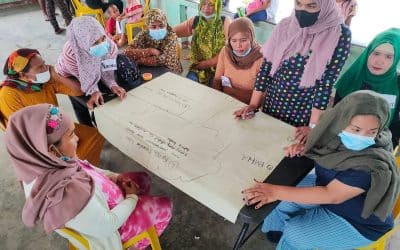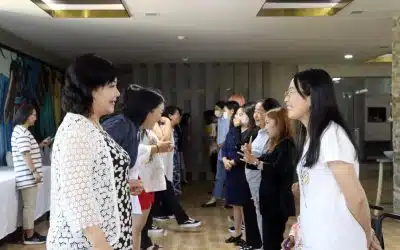InAsia
Insights and Analysis
Investing in Cambodia’s Adolescent Girls
March 13, 2019

In remote, rural locations and provinces near the border with Thailand, pervasive poverty remains a powerful disincentive to education. Child labor and unsafe labor migration are widespread, and drop-out rates for rural secondary schools are high. No one is affected more than the country’s adolescent girls. Just one in three Cambodian girls has the opportunity to finish secondary school, and many students lack the support and the role models they need to imagine opportunities beyond their rural villages. As a result, young people in rural Cambodia often have very limited career aspirations that leave their true potential unrealized.
In Cambodia, a little can go a very long way
In 2017, The Asia Foundation launched Investing in Adolescent Girls Education in Cambodia: Pathways to a Brighter Future. IAGEC has two main objectives: (1) to lower drop-out rates in secondary schools and keep young people in school, eliminating one of the root causes of labor migration; and (2) to empower at-risk, adolescent girls to take leadership roles in school and imagine other education and career pathways that match Cambodia’s changing economic landscape.
In profound yet simple ways, this project has transformed the lives of its young participants. Working with local partner the Khmer Youth Association (KYA), IAGEC has supported 410 students, 80 percent of them girls, at six remote schools in Siem Reap, Kampong Cham, and Prey Veng provinces known for their high drop-out rates and pervasive labor migration. The program uses a two-pronged strategy. First, students and their families receive material support for students’ basic, practical needs—bicycles for getting to school, pens and paper for schoolwork, uniforms, school bags, and rice. Second, IAGEC provides a mentoring and enrichment experience to help students grow personally, academically, and eventually professionally.

AGEC students receiving bicycles, Chilean Hanchey School, Kampong Cham.
While these simple measures may seem basic, the past two years have witnessed remarkable results. Bicycles have made the journey from home to school much easier, lightening the burden of simply being in attendance. A series of career forums has helped students imagine future careers that match their genuine skills and interests by exposing them to the many new possibilities of a growing and developing Cambodia. Debate sessions cultivate critical thinking, English language skills, and confident public speaking, leading to better performance in the classroom and feelings of success and achievement that help keep students engaged with their lessons. Equipping students with essential learning materials lifts an often daunting economic burden, and providing rice to students helps feed their families, allowing critical funds to be redirected to their education.
By increasing incentives to stay in school, and by educating students about the dangers of unsafe labor migration though annual awareness campaigns,IAGEC has reduced the drop-out rate among participating students to 11 percent, compared to a national average of 19 percent. Through mentoring and “exposure visits” to their university-level peers, students gain confidence and the ambition to increase their academic performance.
“Because of the mentoring support, I am much more courageous now,” said Muykea, an 11th grader from Chilean Hanchey Secondary School in Kampong Cham. “I dare to ask questions if I don’t understand. I have the courage to make decisions. I even chose to nominate myself for class representative, a decision I would not have made before.”

Mentoring activity for IAGEC students at 28 Makara School (Siem Reap Province)
Last year, 67 percent of IAGEC students passed their baccalaureate exams, a rate 10 points higher than the average for the six participating schools, and a point higher than the national rate of 66 percent, a slim but symbolic margin for a group of disadvantaged young people who might never have been enrolled.
Exposure visits have led to other positive changes at IAGEC schools, including greater respect among the students for the cleanliness and physical appearance of school facilities and greater responsibility for managing their own trash. Students from 28 Makara School in Siem Reap province adopted for themselves a project they visited at Bakong Secondary School, in the same province, called the Student Written Club, where students create their own reading materials and creative new resources for their peers and school libraries.
The reality facing these students, and all young people in the country, is that Cambodia is developing and changing at an enormous rate. The country is undergoing a transformation from a labor-intensive society to one built on knowledge and education, and the skills and human capital it will need tomorrow are dramatically different than they were just a decade ago. For the current generation of Cambodian young people, programs like IAGEC are an essential bridge to that future.
Lim Siv Hong is a program manager and James O’Keefe is a women and youth empowerment program officer in The Asia Foundation’s Cambodia office. They can be reached at [email protected] and [email protected], respectively. The views and opinions expressed here are those of the authors, not those of The Asia Foundation.
About our blog, InAsia
InAsia is posted and distributed every other Wednesday evening, Pacific Time. If you have any questions, please send an email to [email protected].
Contact
For questions about InAsia, or for our cross-post and re-use policy, please send an email to [email protected].The Asia Foundation
465 California St., 9th Floor
San Francisco, CA 94104
The Latest Across Asia
News
April 25, 2024
Program Snapshot
April 18, 2024
News
April 17, 2024

2024 Lotus Leadership Awards
Thursday, April 25, 2024, New York City
The Lotus Leadership Awards recognize contributions towards gender equality in Asia and the Pacific







0 Comments